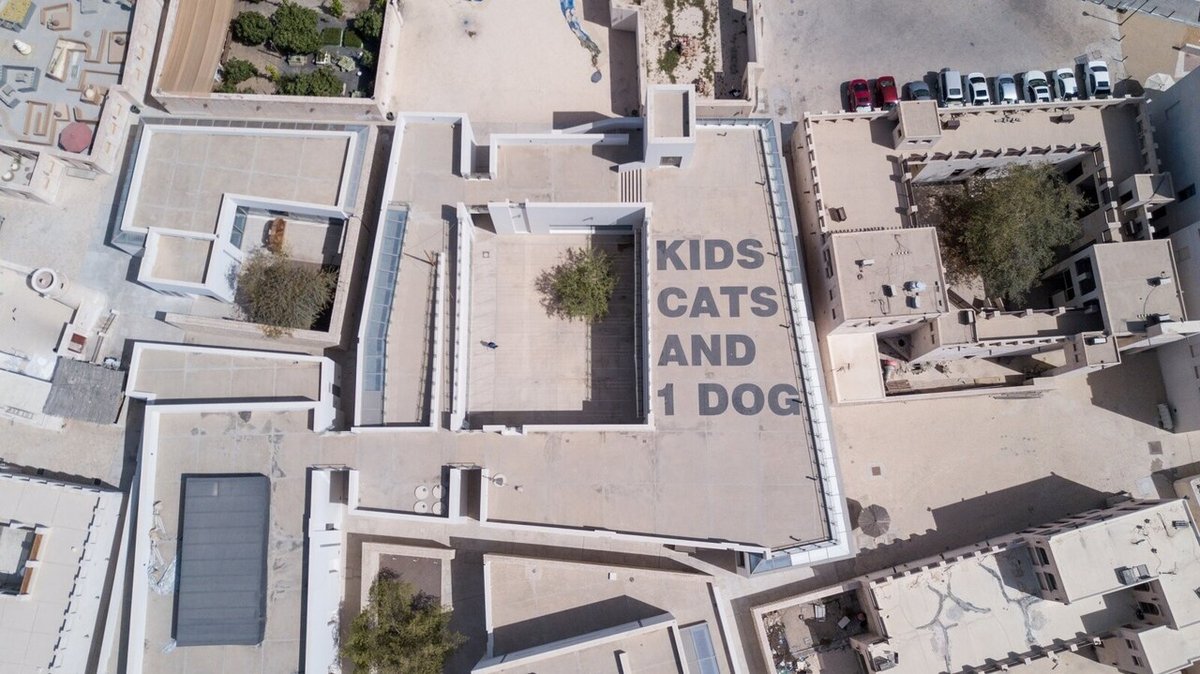
Abbas Akhavan(アッバス・アカヴァン): curtain call, variations on a folly
The English text is shown after the Japanese text.
今回紹介するのは、Chisenhale Galleryで開催されたAbbas Akhavan(アッバス・アカヴァン)の展示です。二つの作品のみというシンプルな構成ですが、内容は濃く、考えさせられるような内容になっています。
アッバス・アカヴァンは、イラン・イラク戦争の際に家族と共にモントリオール(カナダ)へ移住しており、それ以降は、モントリオールを拠点に活動を行なっています。彼は、境界と自然との関係について考えていく中で、彫刻を探究し素材から学ぶことを試みています。場所の歴史的、社会的、建築的構造に注目し、状況に応じてメディアを変えながら制作を行なっています。

パルミラ遺跡 Palmyra


"curtain call, variations on a folly", Installation view © Abbas Akhavan.
一つ目の作品《curtain call, variations on a folly》は、シリアにある2000年前のパルミラ遺跡の記念碑的アーチにアプローチしていた列柱をイメージして作られています。パルミラ遺跡のアーチは、2015年に過激派組織「イスラム国(ISIL)」によって破壊されたと考えられています。その後、2016年にイギリスとアメリカに拠点を置くInstitute of Digital Archaeology(IDA)によって、3D技術を用いて大理石で再現されています。

ロンドン中心部のトラファルガー広場で行われたパルミラの凱旋門のレプリカの除幕式で見守るボリス・ジョンソンロンドン市長(左)
Mayor of London Boris Johnson (L) watches during the unveiling of a replica of Palmyra's Arch of Triumph in Trafalgar Square, central London (AFP/Justin Tallis)
2016年4月19日、ボリス・ジョンソン首相(当時はロンドン市長)とIDAによって、復元されたアーチを公開するための除幕式がロンドンのトラファルガー広場で執り行われました。それに対し、アカヴァンは、パルミラ遺跡のアーチがロンドンという帝国的な場所に運ばれ、その一部となったことを鑑み、その残りの部分を作る必要があると考えました。


Close-up view of "curtain call, variations on a folly" © Abbas Akhavan.
この作品は、緑の幕とコブという、非常に対照的な要素を持つ2つの素材でできています。
緑の幕は、グリーンバックとしてデジタル映像の合成などに用いられますが、作品の中ではアナログ的に使用されています。そうすることで、鑑賞者を一つの空間へと押し込めるのではなく、ギャラリーという枠の外へと導き、各々が想像上の空間を思い描くように促しています。つまり、この緑の幕にはどのような場所を当てはめても良いのです。ある人は、シリアの風景を思い浮かべるかもしれませんし、ある人は、誰かの家の裏庭を思い浮かべるかもしれません。ギャラリーという舞台の中に、さらにバーチャルな舞台、演劇的には「第四の壁」と言われているものを作り出しているのです。
一方コブは、下層土と水と藁を混ぜて作られた古代の建築材料で、有機的、安価、乾燥が早い、縮まない、無害、生分解性といった特徴を持つサステナブルな資材です。(会期後は、堆肥として再利用されます。)この素材は、アカバンの子供時代の記憶や経験に強く影響を受けています。アカヴァンは、制作において、感触は場所よりも重要な要素だと述べています。


"cast for a folly", Installation view © Abbas Akhavan.

Close-up view of the "cast for a folly" lion statue © Abbas Akhavan.
彼は、過去にも《cast for a folly》という似たような形態で作品を制作しています。ちなみにこの作品は、2003年にイスラム国によって略奪されたイラク国立博物館のロビーを再現しています。(2009年に再開しました。)正確には、再現というよりも、アーティストによる再構成といった方が正しいかもしれません。巨大なライオンの石像(作品ではコブを使用)を中心に縮尺を変えたロビーは、不気味な雰囲気が漂っています。ここでは、緑の幕は、ロビーに侵入された場所にかけられており、破壊を示唆する第四の壁を表しています。
このようにアカヴァンは、彫刻が演じるその先のもの、つまりは、物質性や時間制、文脈などを見るように促します。そして、Reproduction(再現)とは何か、遺跡とギャラリー空間との関係性とは何か、といった疑問を提示します。
最初にギャラリーに入ると、空間を大きく使った作品で非常に壮大さを感じますが、見ているうちに、また作品について調べていくうちに、なんとも繊細で、儚く、脆いものであるように感じる作品でした。

"CAT'S PAW”, Installation view from the above © Abbas Akhavan.
二つ目は、《CAT`S PAW》という、ギャラリーの建物の屋上に大きな文字で描かれた作品で、実際には見ることが出来なくなっています。(近隣の高い建物や、ドローン、飛行機などからは見ることができます。)
「cat’s paw」は、ジャンヌ・ド・ラ・フォンテーヌが1967年に発表した寓話『猿と猫(The Monkey and The Cat)』に由来する慣用句です。猿が、何も知らない猫に対し、焼けた栗を取るように説得し、結局は最後に全てを自分のものにするというお話です。つまり、誰かが誰かの意に反して利用する、今で言うと、他人のダシや道具になる人のことを指す言葉です。


"Kids, Cats and 1 Dog", Installation view from the above © Abbas Akhavan.

Indoor installation of "Study for a Blue Shield" © Abbas Akhavan.

"Study for a Blue Shield", Installation view from the above © Abbas Akhavan.
この作品も同様に、《Kids, Cats and 1 Dog》や《Study for a Blue Shield》といった同系統の過去作があります。これらは、どれもが都市を俯瞰的な視点で、要は客観的に見るように気づかせてくれます。ギャラリーは単に研究対象を提示する場として存在するべきなのか。それともオーディエンスに枠の外を見るよう疑問を投げかけるべきなのか。
このような視点で、彼の作品を考えてみると共通する問題意識が見えてきます。
何だか私には、「あなたは社会におけるcat’s pawになっていませんか」、「あなたの作品はギャラリーのcat’s pawになっていませんか」、と訴えかけてくるように感じます。
Abbas Akhavan: curtain call, variations on a folly
I want to introduce you to Abbas Akhavan's exhibition at Chisenhale Gallery. It is a simple exhibition of only two works, but the content is rich and thought-provoking.
Abbas Akhavan emigrated to Montreal (Canada) with his family during the Iran-Iraq war and has been there ever since. He explores sculpture and learns from materials as he considers the relationship between boundaries and nature. His work focuses on a place's historical, social, and architectural structures, using different media depending on the situation.
The first piece, "Curtain call, variations on a folly", is inspired by the colonnades that approached the monumental arch of Palmyra, a 2000-year-old site in Syria. The arch at Palmyra is believed to have been destroyed by the Islamic State (ISIL) militant group in 2015. It was then recreated in marble in 2016 by the Institute of Digital Archaeology (IDA), based in the UK and USA, using 3D technology.
On 19th April 2016, a ceremony was held in London's Trafalgar Square by Prime Minister Boris Johnson (then Mayor of London) and the IDA to unveil the restored arch to the public. In response, Akhavan decided that, given that the arch of Palmyra had been transported to and became part of the imperial site of London, it was necessary to build the rest of it.
The work is made of a green curtain and a cob, two materials with very contrasting elements.
The green curtain is used as a green backdrop for compositing digital images, but it is used in an analogue way in the work. In doing so, the gallery does not confine the viewer to a single space. Still, it takes them outside the confines of the gallery, encouraging them to imagine their own imaginary space. In other words, the green curtain can be applied to any place. It may be a Syrian landscape; for others, it may be the backyard of someone's house. Within the gallery setting, we are creating a virtual environment, what in theatrical terms is known as the 'fourth wall'.
On the other hand, cob is an ancient building material made from a mixture of subsoil, water and straw, which is organic, inexpensive, fast-drying, non-shrinking, harmless and biodegradable. (The material will be reused as compost after the exhibition.) The material is strongly influenced by Akhavan's childhood memories and experiences. In his work, Akhavan says that feeling is more important than place.
He has made similar work in the past called "cast for a folly". Incidentally, this work recreates the lobby of the Iraqi National Museum, which was looted by the Islamic State in 2003. (It was reopened in 2009.) However, it is more of an artist's reconstruction than a re-creation. The lobby, scaled-down around a colossal stone statue of a lion (made of cob in work), has an eerie atmosphere. Here, a green curtain hangs over the invaded lobby, representing a fourth wall that suggests destruction.
In this way, Akhavan encourages us to look beyond the sculptures' acts: materiality, temporality and context. He then poses the questions: what is Reproduction, and what is the relationship between the site and the gallery space?
When I first entered the gallery, I felt the work was very grand, using a lot of space, but I thought it was very delicate, fleeting, and fragile as I looked and studied it.
The second is "CAT'S PAW", a large text on the roof of the gallery building, which cannot be seen in person. (You can see it from tall buildings, drones and planes in the neighbourhood.) The phrase "cat's paw" is an idiom derived from Jeanne de la Fontaine's 1967 fable "The Monkey and The Cat". The story is about a monkey who persuades a cat, who knows nothing about the story, to take a roasted chestnut and, in the end, gets it all for himself. In other words, it is a term for someone who uses someone against their will, or as we would say nowadays, someone who becomes someone else's dupe or tool.
This work is similar to previous works in the same vein, such as "Kids, Cats and 1 Dog" and "Study for a Blue Shield". All of them remind us to look at the city from a bird's eye view, in short, from an objective point of view. But, should the gallery exist merely as a place to hold research objects? Or should it ask its audience to look outside the box?
Considering his work from this perspective, we can see a shared awareness of the issues involved.
It seems to me to be asking, "Are you the cat's paw of society?" or "Is your work the cat's paw of the gallery?"
NOBU
【展示 Exhibition】
Chisenhale Gallery - Abbas Akhavan
【参考文献 References】
The Guardian
Akhavan, Abbas. (2018) Abbas Akhavan. Milano: Skira.
Catriona Jeffries
Sharjah Art Foundation
Canadian Art Foundation
この記事が気に入ったらサポートをしてみませんか?
